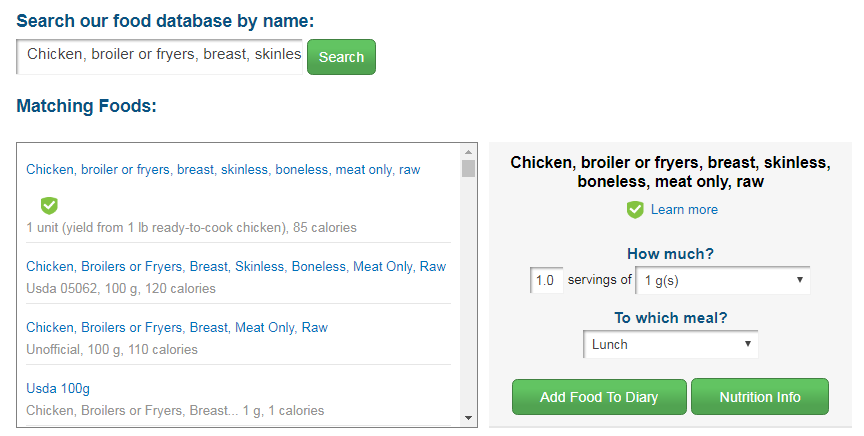Calories in 100g raw chicken breast?

goatelope
Posts: 177 Member
There are so many different entries, I’m struggling to work it out
0
Replies
-
Unfortunately, the "verified" green check marks in the MFP database are used for both user-created entries and admin-created entries that MFP pulled from the USDA database. To find admin entries for whole foods, I get the syntax from the USDA database and paste that into MFP.
Note: any MFP entry that includes "USDA" was user entered.
So plug "Chicken, broiler or fryers, breast, skinless, boneless, meat only, raw" into the MFP database.
Now unfortunately there is an issue with some admin entries that has been going on for years without a fix - this says 1 g but is actually for 100 g. So if you get 100 x more calories than you think you should get, pretend "How much" > 1 g actually says 100 g and all is well.

0 -
I’m pretty sure you’re in the UK and you, at least sometimes, shop at Sainsbury’s.
What I always do is use the supermarket as a start and keep the search term as straightforward as I can.0 -
Well the problem is that on your chart it says 94 calories per 100g, but in other places it calculates it as 110 calories per 100g. I cooked a large chicken breast and that would mean almost 30 calories difference. Wherever I look, I get a different value0
-
I would recommend exactly what kshama says above.
However, if you have packaging information for the chicken breast (which is normally raw unless it specifies), then I would go with it. The reason is that some packaged chicken may be pumped up with a saline solution. (I would suspect that's the case for chicken breast claiming to be only 94 cal and 20 g protein at 100 g.)
If chicken breast is not something you have a lot, 30 cal does not matter.
More important, if chicken breast is something you have a lot, be consistent. If you aren't losing as much as expected (or are losing more), you can adjust overall cals to respond to that. That's how we deal with the fact logging may not be perfect or our TDEE estimates may be off or whatnot. For logging, consistency is the key. When I was logging I got all of my meat from a farm that didn't have fat percentages or cals or anything (and I rarely eat boneless, skinless chicken breast), so I guessed based on the various USDA options. It worked fine, but if I hadn't lost as expected I would have modified my cals.1 -
Ok, I see what you mean, and that’s actually helpful. Many thanks! Big learning curve for me1
This discussion has been closed.
Categories
- All Categories
- 1.4M Health, Wellness and Goals
- 398.2K Introduce Yourself
- 44.7K Getting Started
- 261K Health and Weight Loss
- 176.4K Food and Nutrition
- 47.7K Recipes
- 233K Fitness and Exercise
- 462 Sleep, Mindfulness and Overall Wellness
- 6.5K Goal: Maintaining Weight
- 8.7K Goal: Gaining Weight and Body Building
- 153.5K Motivation and Support
- 8.4K Challenges
- 1.4K Debate Club
- 96.5K Chit-Chat
- 2.6K Fun and Games
- 4.8K MyFitnessPal Information
- 12 News and Announcements
- 21 MyFitnessPal Academy
- 1.5K Feature Suggestions and Ideas
- 3.2K MyFitnessPal Tech Support Questions



